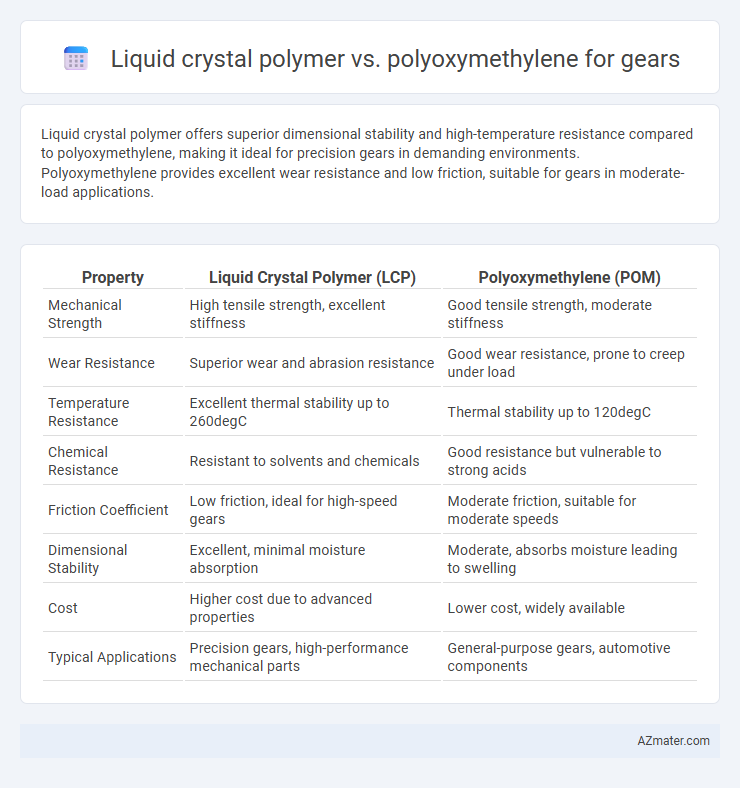Liquid crystal polymer offers superior dimensional stability and high-temperature resistance compared to polyoxymethylene, making it ideal for precision gears in demanding environments. Polyoxymethylene provides excellent wear resistance and low friction, suitable for gears in moderate-load applications.
Table of Comparison
| Property | Liquid Crystal Polymer (LCP) | Polyoxymethylene (POM) |
|---|---|---|
| Mechanical Strength | High tensile strength, excellent stiffness | Good tensile strength, moderate stiffness |
| Wear Resistance | Superior wear and abrasion resistance | Good wear resistance, prone to creep under load |
| Temperature Resistance | Excellent thermal stability up to 260degC | Thermal stability up to 120degC |
| Chemical Resistance | Resistant to solvents and chemicals | Good resistance but vulnerable to strong acids |
| Friction Coefficient | Low friction, ideal for high-speed gears | Moderate friction, suitable for moderate speeds |
| Dimensional Stability | Excellent, minimal moisture absorption | Moderate, absorbs moisture leading to swelling |
| Cost | Higher cost due to advanced properties | Lower cost, widely available |
| Typical Applications | Precision gears, high-performance mechanical parts | General-purpose gears, automotive components |
Introduction to Engineering Plastics for Gears
Liquid crystal polymer (LCP) and polyoxymethylene (POM) are prominent engineering plastics used for manufacturing gears, each offering distinct mechanical properties. LCP provides superior dimensional stability, high strength, and excellent chemical resistance, making it ideal for high-performance and precision gear applications. POM is known for its low friction, wear resistance, and good machinability, commonly used in standard gear designs requiring reliable mechanical performance and cost-effectiveness.
Overview of Liquid Crystal Polymer (LCP)
Liquid Crystal Polymer (LCP) exhibits outstanding thermal stability, mechanical strength, and chemical resistance, making it ideal for precision gear applications subjected to high stress and elevated temperatures. Its low coefficient of friction and excellent dimensional stability outperform traditional Polyoxymethylene (POM) in high-performance environments. LCP's anisotropic molecular structure provides superior wear resistance and reduced deformation, enhancing gear longevity and efficiency.
Overview of Polyoxymethylene (POM)
Polyoxymethylene (POM), also known as acetal, is a high-performance engineering thermoplastic widely used for precision gears due to its excellent mechanical strength, low friction, and high wear resistance. POM demonstrates superior dimensional stability and chemical resistance, making it ideal for applications requiring durability under continuous stress and exposure to lubricants or solvents. Compared to Liquid Crystal Polymer (LCP), POM provides a cost-effective solution with good impact resistance, though LCP offers higher temperature tolerance and rigidity for specialized gear applications.
Mechanical Properties: LCP vs POM
Liquid crystal polymer (LCP) exhibits superior mechanical properties over polyoxymethylene (POM) for gear applications, including higher tensile strength and excellent dimensional stability under load. LCP maintains rigidity and wear resistance at elevated temperatures, whereas POM tends to soften and deform under similar conditions. The high melting point and low friction coefficient of LCP contribute to enhanced gear performance and longevity compared to the tougher but less heat-resistant POM.
Thermal Performance in Gear Applications
Liquid crystal polymer (LCP) exhibits superior thermal stability with a continuous use temperature above 260degC, making it ideal for high-temperature gear applications where dimensional stability is critical. Polyoxymethylene (POM), also known as acetal, has a lower melting point around 175degC and tends to deform under prolonged thermal stress, limiting its use in high-heat environments. The enhanced thermal resistance of LCP ensures better wear resistance and maintains mechanical properties in gears subjected to elevated temperatures compared to POM.
Wear Resistance and Durability Comparison
Liquid crystal polymer (LCP) offers superior wear resistance compared to polyoxymethylene (POM) due to its high molecular orientation and low friction coefficient, making it ideal for high-performance gears subjected to continuous friction. LCP's enhanced dimensional stability and resistance to chemical degradation contribute to greater durability under harsh mechanical and thermal conditions, outperforming POM in long-term gear applications. Polyoxymethylene, while exhibiting good wear resistance and toughness, tends to have higher susceptibility to creep and wear under heavy loads, resulting in shorter gear lifespan compared to LCP.
Chemical Resistance and Environmental Stability
Liquid crystal polymer (LCP) offers superior chemical resistance compared to polyoxymethylene (POM), excelling against acids, solvents, and fuels, making it ideal for harsh industrial environments. LCP maintains dimensional stability and mechanical strength at elevated temperatures and in humid conditions, whereas POM is more prone to hydrolysis and degradation under UV exposure and moisture. These properties position LCP as the preferred gear material where chemical exposure and environmental stability are critical.
Processing and Manufacturability Differences
Liquid crystal polymers (LCP) offer superior dimensional stability and chemical resistance compared to polyoxymethylene (POM), making them ideal for high-precision gears exposed to harsh environments. LCP processes with faster cycle times due to lower melt viscosity but require higher mold temperatures and more precise injection molding conditions, while POM is easier to machine and mold at lower temperatures with excellent flow characteristics, benefiting cost-effective production. The choice between LCP and POM for gears hinges on balancing the demanding processing parameters of LCP against the simpler manufacturability and broader application versatility of POM.
Cost and Availability Considerations
Liquid crystal polymer (LCP) generally incurs higher costs compared to polyoxymethylene (POM) due to its superior mechanical properties and heat resistance, making it preferable for demanding gear applications. Polyoxymethylene is widely available and economically favorable for producing gears in large volumes where moderate strength and wear resistance are sufficient. Availability of POM in various grades supports easier sourcing and cost-effective manufacturing, while LCP's specialized supply chain can lead to longer lead times and increased material expenses.
Choosing the Right Material: LCP or POM for Gears
Liquid crystal polymer (LCP) offers superior wear resistance, high strength, and excellent dimensional stability, making it ideal for precision gears subjected to high loads and temperatures. Polyoxymethylene (POM) provides good machinability, low friction, and excellent chemical resistance, suitable for gears operating in moderate stress environments with a need for cost efficiency. Choosing LCP for gears ensures enhanced durability and performance in demanding applications, while POM suits economical solutions with balanced mechanical properties.

Infographic: Liquid crystal polymer vs Polyoxymethylene for Gear
 azmater.com
azmater.com